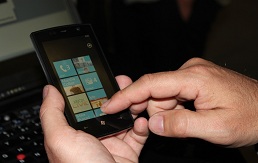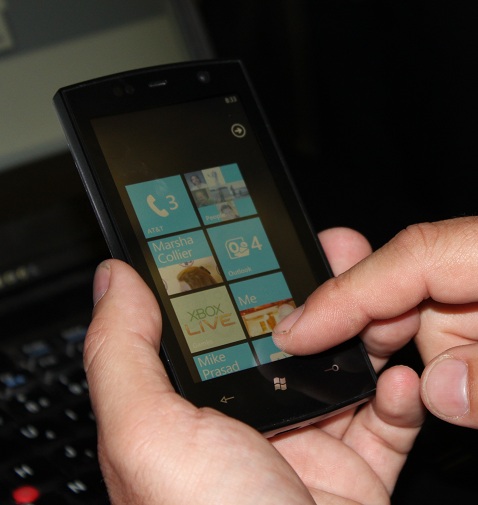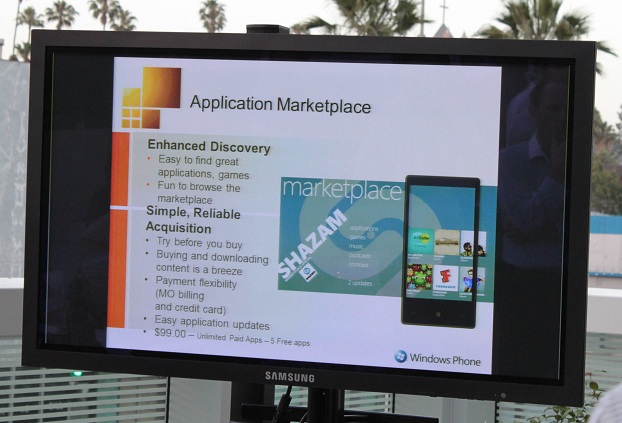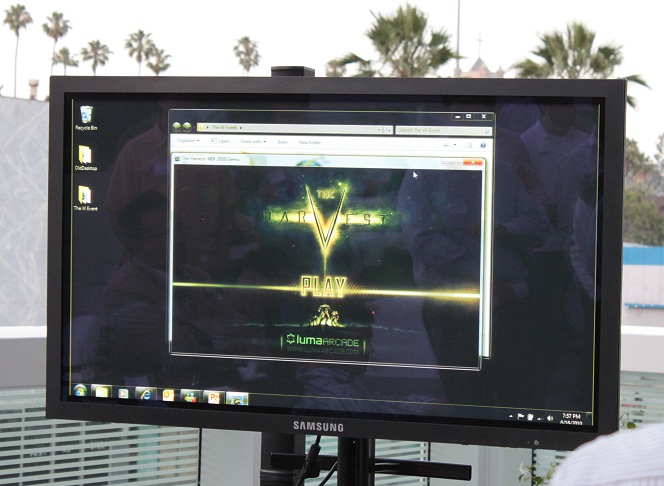Quality Time with Windows Phone 7
We feasted our eyes on Microsoft' Windows Phone 7. Find out what details we learned about the hardware, OS, and application development.


Windows Phone 7, Microsoft’s smartphone operating system set to launch later this year, has been talked about plenty since it was first unveiled back in February. Videos, images and other bits info have hit the web--either via Microsoft directly, or due to leaks from phone-watchers. People who pay close attention to these things already have a good sense of where this mobile OS is going.
But not everyone has gotten a chance to see a Windows Phone 7, up close and personal. Tom's Guide feasted its eyes on a Windows Phone 7 At an application developer event hosted by Microsoft in Hollywood.
This ogling session yielded a few tidbits of previously unknown information. For instance, the manufacturer of the handset we saw was not actually listed on the device, but sources indicate that the devices at the event were made by Dell or Acer (or, possibly, both).
Due to the minimum hardware requirements for WP7, we already know that these devices have certain features like a capacitive touchscreen with at least four control points, 256 MB of RAM, 8 GB of storage, a 5 megapixel camera, Direct X 9 graphics, and an ARMv7 Cortex/Scorpion CPU. Again these are all minimum specs, so a version with a camera, 16 GB of storage and an 8 MP camera wouldn’t come as a surprise. While we were not allowed to touch the phone, we did witness the screen on this Dell/Acer device in action, and the response was very smooth.

Here's what we learned about the WP7 app developing process. Anyone can develop apps for WP7, for free. Tools like Expression Blend 4 and Visual Studio 10 Express are free. Developers can create as many paid apps (apps that cost money to buy in an app store) as they want, as well as up to five free apps. If developers want to create more free apps, there is a fee of $19.95 for each additional app. In order to list apps for WP7 in the store environment, Microsoft charges a one-time fee of $99.99. This fee covers the developer for life, no strings attached (as far as we know).

This gets even more attractive for students, who, through Microsoft’s DreamSpark program, can not only obtain devs tools for free, but the listing fee is waived. As long as someone has a .edu email address, he can create and list apps for WP7 for free.
Listen up, game developers. Because games for WP7 will be created in Silverlight, XNA3 or XNA4 (XNA is the environment that Xbox Live Arcade games are created in), any dev can easily port their WP7 game in Windows 7, Xbox Live Arcade, or the Zune Marketplace (after some minor resolution tweaks). In short, one game can be seamlessly ported to a desktop, laptop, Zune HD, and Xbox 360, which means more money in the pockets of small indie game developers.
Sign up to get the BEST of Tom's Guide direct to your inbox.
Get instant access to breaking news, the hottest reviews, great deals and helpful tips.

After our time with WP7, we can safely say that this newest mobile OS out of Redmond will give Android, BlackBerry OS 6 and iPhone OS 4 some serious competition. Indie devs, start your coding.
…and while this has nothing to do with WP7, seeing a seven story tall Inception poster across the way from this event was pretty awesome, too.
Devin Connors currently works as a community manager for Rocket League at Psyonix Studios, but he was previously a senior editor at Tom's Guide, writing about gaming, phones, and pretty much every other tech category. His work has also appeared in publications including Shacknews, GameZone, The Escapist, Machinima, and more.
-
Cross platform ability for games to go between Xbox and Windows PC has been around for 3 years, and ignored by developers.Reply
-
dconnors Field MouseCross platform ability for games to go between Xbox and Windows PC has been around for 3 years, and ignored by developers.Reply
Good point. I think that will change somewhat with the advent of app stores for mobile devices, however. This might not apply to PCs all too much, but I think you will see a lot of games go between XBLA, the Zune HD and the WP7 platform.
-Devin -
long2know Wow - I got to touch the phones at TechEd at least. As with all MS products, the main benefits will be for developers and nice IDE's. The various demonstrations at TechEd with regard to developing apps with Silverlight (Expression Blend), XNA, etc, were pretty cool. But, the phone still had some serious limitations, and I'm think it will ultimately be too little too late. Rumors have it that the phone won't be released until Q1 2011 as well.Reply -
hiruu I'm waiting on this OS to decide which mobile platform to go with...that Dell Lightining looked incredible, but I've got to see them all running to make a final call.Reply -
The multitasking is a little concerning, although the way they're doing it should minimize the biggest issues (and they've said it's a v.next feature, which I hope they stick to). In terms of copy and paste, though, I have had WinMo now for ages, have had the feature, and I think I might have needed to use it once in all those years. I'm seriously not even concerned about that. Now if they build a WinPho7 tablet and it doesn't have copy and paste, then I'll jump on the soapbox and scream pretty loudly that this is a huge issue....Reply
-
sailfish I hope the article's picture is a true representation of the phone's degree of vividness. It really looks faded and washed out.Reply
